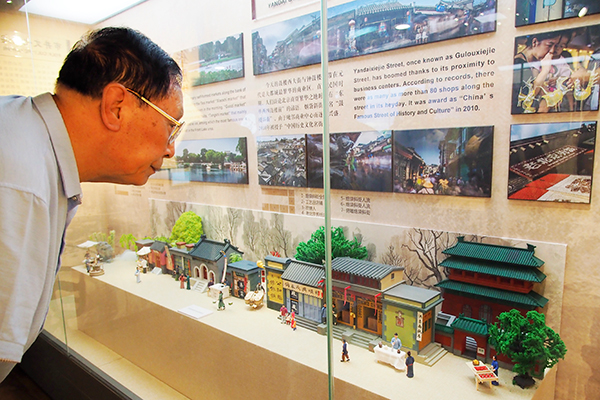 |
A visitor examines exhibits at the Beijing Shichahai Cultural Exhibition Center on Thursday.[Photo by Du Jianpo/For China Daily] |
Hundreds of works go on display in new exhibition center in renovated temple
Beijing's downtown area is speeding up the preservation of immovable cultural relics as part of a campaign to better protect and utilize the city's cultural heritage amid rapid urbanization, a senior official in the capital said last week.
Beijing Shichahai Cultural Exhibition Center opened to the public on Thursday in order to showcase the history and culture of the capital, a city with more than 3,000 years of history. The center is located in the Guangfu Temple, a Taoist temple dating back to 1459 during the Ming Dynasty (1368-1644).
The temple has been given new life since residents moved out and buildings were restored. It is one of many ancient buildings around Shichahai Lake, an area packed with traditional Ming Dynasty courtyards that is one of the oldest neighborhoods in Beijing.
Lu Yingchuan, Party chief of Beijing's Xicheng district, where Shichahai is located, said the district will strengthen renovation of the old town's appearance and functions to improve the quality of life and better protect cultural relics, a move in line with the ongoing application for World Heritage status for the city's central axis.
"We have specifically separated the cultural functions of each block in Xicheng, based on local characteristics, to better showcase the historical and cultural heritage," he said, adding that every block has, since May, had a duty planner responsible for street layout and planning.
According to the city's Planning and Natural Resources Commission, the duty planner is an independent third party who can provide planning, construction and management advice to help protect their area. The employment term for duty planners is usually four to five years.
Thanks to the duty planners, the work of relocating cultural relics in Xicheng district has progressed smoothly, the district government said, with 52 relocation projects completed so far.
Some of the halls in Guangfu Temple were destroyed by natural disasters during the Qing Dynasty (1644-1911) and it was later occupied by residents. The local government moved them out in 2008 and discovered colorful murals from the Qing Dynasty during renovation work.
Bi Jundong, director of the Shichahai Lake street office, said the renovated Guangfu Temple, covering an area of 1,530 square meters, exhibits hundreds of works including paintings, calligraphy and replicas of study furniture from Ming Dynasty in six exhibition halls.
Bi said the cultural exhibition center has multimedia displays featuring digital sandboxes, mobile augmented reality and multi-touch screens to help visitors discover the area's traditions and culture.
Visitors welcomed the opening of the heritage site around Shichahai Lake.
Wang Hongxia, 55, who visited the center with friends on Thursday morning, said, "It's good for us to have access to authentic cultural heritage, especially near my community; previously, I could only walk by the door."
First created in the Yuan Dynasty (1271-1368), Beijing's original central axis was 3.7 kilometers long. It was extended during the Ming and Qing dynasties.
Fourteen historical sites along the axis, including Qianmen Gate, the Forbidden City, Jingshan Park, the Drum and Bell towers, Chairman Mao Zedong Memorial Hall, the Monument to the People's Heroes and Tian'anmen Square have been identified as key heritage sites.
The Beijing authorities earlier unveiled a development plan for the central axis from 2016 to 2035.